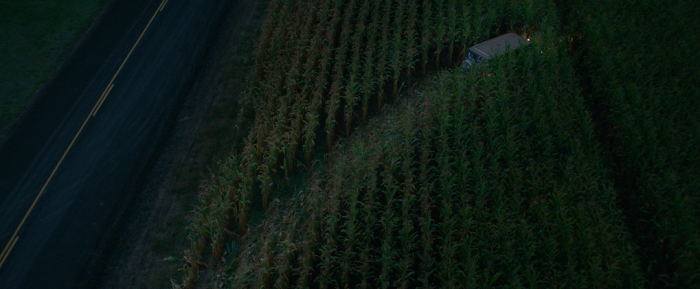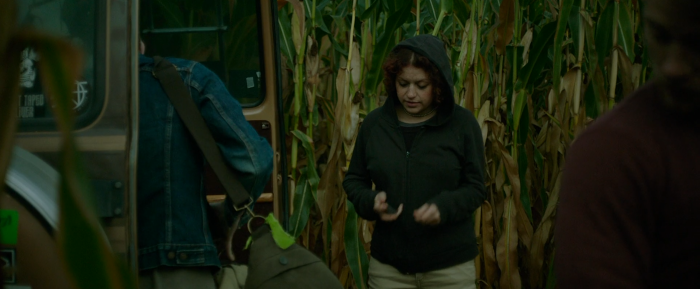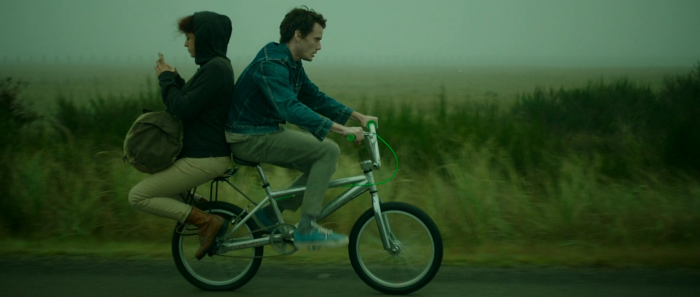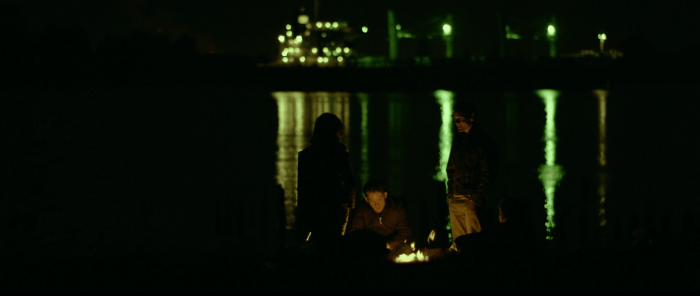

‘Green Room’ Is Undoubtedly One of the Best, Most Relevant Films of the 21st Century
By Petr Navovy | Film | June 15, 2022 |
By Petr Navovy | Film | June 15, 2022 |

It all begins in that cold, thin, barely-light of a morning in the Pacific Northwest. A van has driven off-road into a corn field, its short path to respite there drawn starkly by a beautiful overhead shot. The atmosphere is heavy. You can feel the chill emanating from the screen, the dew nigh on seeping through. The grass is a shade of green that defies description, impossibly verdant, simultaneously otherworldly and grounded; and there is a stillness in the misty air, almost as if something was lurking, waiting, somewhere out there in that grey obscurity. When we zoom in to the van and meet our main players in all this, they are huddled inside, asleep, hoodies and blankets barely protecting them against the cold. Yet there is a warmth in all this, too. A sense of peace and a feeling of home, a home that exists away from the things that most people associate with the concept; and a camaraderie in the face of a hostile world, a communal, spiritual campfire holding back the wolves—if just barely.


It’s probably not the part that most people think of first when they remember Jeremy Saulnier’s 2015 horror-thriller Green Room, but for me those opening moments remain some of the most indelible in recent years. And that’s despite some very stiff competition, even just in Green Room itself—because my god, if ever there was a film just absolutely stacked with images!, their horrifyingly visceral power and emotional resonance searing your soul. The red laces. The gnashing teeth. The box cutter. I first saw the film in Paris in mid-2016 and it was the closest I’d ever come to physically destroying a part of a cinema. When the credits rolled, I had to consciously unclench every single part of my body. My fingers had dug themselves into the armrests, gouging out sweat-stained grooves there, and my quads were seizing up from too long spent in a fight-or-flight spasm. I imagine that for most people, this tension is Green Room’s defining feature. And it is undoubtedly a highlight, as Saulnier’s command of tension—in this film as well as his other features—is remarkable. The movie is wound as tight as a steel coil. Yet despite that, it finds the space to breathe, to give the tension its counterpoint, thus enhancing its power exponentially. It’s there in those spaces that it really becomes magic. In a film filled so memorably with blood and guts, it’s the other side of the equation that always sticks with me: The melancholy, the loss, the solidarity.

Having rewatched it recently it really is remarkable just how brutally efficient and lean Saulnier’s second (!) film is. There is not a moment wasted. He uses every minute of the 95 he has here incredibly effectively, starting with that cold morning in the corn field. I’ve touched on this topic before, but it really is a trip to think of how well done the first eleven minutes or so of this movie are—especially when seen in the context of the whole. All the carnage that follows, all the nerve-shredding suspense and flinch-inducing violence, all of it rests on the foundations that the opening puts into place. Once Green Room gets going, it moves at a relentless pace, its internal logic leading it down a path of unbearable tragedy that you feel in the pit of your stomach must be coming. But it takes its time beforehand in order to give this the gravity it needs, both in terms of setting up the plot mechanics, but also—fundamentally—in the connection it forges between us and the people at the heart of the approaching whirlwind. Michael Mann’s Heat is one of the greatest films ever made (and my particular favourite). There are times when Green Room calls to my mind that stunning achievement. In its fusion of character work and action, and its command of atmosphere and mood—including its synth-heavy soundtrack—I can’t help but occasionally recall the lonesome twinkling of L.A. lights, and the accompanying soundscapes conjured up by Elliot Goldenthal, of Mann’s masterpiece.
The tight unit of The Ain’t Rights is our anchor in the film’s world of sliced and torn flesh. Callum Turner, Alia Shawkat, Joe Cole, and the one and only Anton Yelchin all play their instruments and sing for real in the film—they all already knew how to, or they learned for the part—and that verisimilitude is reflected in the bond between the characters that the actors project. Remarkably quickly, you fully believe that these guys are a working punk band, with that opening in the van establishing the material world they inhabit—all aching necks, cold mornings, and the siphoning of fuel—as well as their connection. The sense of a group that doesn’t have, and indeed doesn’t attach much importance to, anything else in the world but each other and their music, is foundational to everything that will follow. Once The Ain’t Rights enter the den of Nazis in that isolated part of Oregon’s forests, they are well and truly on their own, the hostile world has suddenly grown more hostile than ever in a dramatically rapid and dangerous way. Green Room sets this up ingeniously in an earlier scene in which the band is interviewed by a local DIY punk radio DJ, who asks them why they have no social media presence. For The Ain’t Rights, it’s a matter of principle: It’s the music that should speak for itself, preferably through the ephemeral magic it generates in a live setting; everything else is a distraction at best and a poison at worst. For the audience, this sits with us as they roll into the deadly gig, and it gradually comes back to the front of our minds as things escalate: Nobody knows they’re there. Once their phones are taken out of action, that’s it. They’re well and truly on their own.


Green Room has an intense intimacy, a real affection and love for its characters and the DIY punk circles they move in. This makes a lot of sense once you know that much of it is informed by Jeremy Saulnier’s (or his friends’) past and experiences as a punk fan and performer: Waking up in a cornfield, playing to a diner populated by indifferent members of the public—these are events drawn straight from reality, and—speaking as someone who also used to play in a low budget band—they are not inaccurate reflections of that kind of life. There, you put everything you have into what you do. Money, energy, blood, sweat, and tears, it all goes in. More often than not to minimal material return. But that’s alright because that’s not what matters in the end. It’s the intangible stuff that it’s all about. Saulnier understands this world and mentality deeply, and he respects it. That lived-in feel, that love for those just about scraping a living and life together on the harsh, unforgiving borders of modern capitalism is a theme that is prevalent throughout the director’s work (and please go read the phenomenal piece that my friend Roxana wrote about that not long ago). Indeed there’s something of The Ain’t Rights defiant anti-corporate spirit in Saulnier himself, who reportedly turned down a number of mainstream Hollywood offers after the success of his debut, Blue Ruin, in order to pursue the fiercely personal project that is Green Room. In a world in which industry pressures make it a near inevitability for seemingly every up-and-coming indie director to get hoovered up into the spirit-crushing maw of the Marvel/comic book movie blockbuster machine, to defiantly turn the other way and follow your own path is an applause-worthy feat.
Lest it feel like I’m underselling the pulse-pounding thrills contained in the film, however, let me reiterate: Saulnier conjures up moments of dread in Green Room that are among the most powerful in memory. From the moment the The Ain’t Rights arrive at that bar, rolling off the road and into tragedy, the camera confined to a cramped, confined view from the backseat of their van, the tension immediately starts to seize control of your body. From then on it’s a steady ratcheting up until things explode so spectacularly backstage in that horrible little room that we’ll come to know so well. The entire extended sequence which takes up the majority of the film—of the band trapped, and repeatedly trying to make it out, only to have to retreat and return, more bloodied and in lesser numbers, over and over again—is exceedingly harrowing, with some parts that can have even not usually squeamish viewers instinctively reaching for something to cover their eyes with. Moments like the ravaging of Yelchin’s hand are truly disturbing to see, as much so for the staging and the impressive practical effects as for the actor’s dedicated and fully believable performance. Green Room has sensitivity and empathy to spare, but it’s also hard and unforgiving as steel, because it knows that’s the way the world is. The violence in this movie is brutal and explicit, yet grounded in a reality that is all-too familiar, and painfully relevant. It’s a horror film in which the monsters are not ghosts or poltergeists or other creatures of some nether realm; they are people, of the sort that don’t just exist in our world, but which have become greatly emboldened in recent years. Green Room understands something that a lot of political commentators and players do not: When you are trapped somewhere with those who want you dead, there is no compromise. Once people show you who they are, believe them, or you risk it all. They might come with sweet words at first, and they might try to put on a reasonable tone initially, but a Nazi is a Nazi is a Nazi. Green Room came out in the middle of the last decade. It understood better then than what some do now: You can’t bargain with fascism. You can’t compromise with people who want to see you destroyed. A lot of people would do well to heed its message.

← Oh My! First Look at Ryan Gosling's Sexy Sexless Ken in the 'Barbie' Movie | After Being Fired from 'Alias,' Coke-Addicted Bradley Cooper Attributes Life Change to Will Arnett →
More Like This
The Problem with Peacock's 'Apples Never Fall' Is Its Infuriating Ending [Spoilers]
David Dastmalchian's 'Late Night with the Devil' Takes the Late-Night Wars into the Horror Genre
Review: 'Damsel' Needs Saving from the Soulless Netflix Formula
'The Girls on the Bus' Is 'The West Wing' Crossed with a Live, Laugh, Love Poster
Manifest Destiny Made Flesh: 'Ravenous' Turns 25

The Experiment With Diversity Is Over in Late Night TV, Suggests Dulcé Sloan
Jordan Klepper Got A "Glimmer Of Hope" From A Trump Supporter
Leave Josh Peck Alone, Says Drake Bell in the Wake of 'Quiet on the Set' Revelations
Sophie Turner Has ‘Reactivated’ Her Divorce From Joe Jonas
Is Aaron Taylor-Johnson The Next James Bond?
Sydney Sweeney Is All Business When It Comes to ‘Madame Web’: ‘That Film Was a Building Block’
More Like This
The Problem with Peacock's 'Apples Never Fall' Is Its Infuriating Ending [Spoilers]
David Dastmalchian's 'Late Night with the Devil' Takes the Late-Night Wars into the Horror Genre
Review: 'Damsel' Needs Saving from the Soulless Netflix Formula
'The Girls on the Bus' Is 'The West Wing' Crossed with a Live, Laugh, Love Poster
Manifest Destiny Made Flesh: 'Ravenous' Turns 25
Reviews